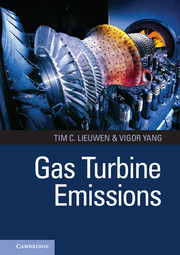Book contents
- Frontmatter
- Contents
- List of Contributors
- Foreword
- Preface
- Part 1 Overview and Key Issues
- Part 2 Fundamentals and Modeling: Production and Control
- Part 3 Case Studies and Specific Technologies: Pollutant Trends and Key Drivers
- 9 Partially Premixed and Premixed Aero Engine Combustors
- 10 Industrial Combustors
- Index
- References
10 - Industrial Combustors
Conventional, Non-premixed, and Dry Low Emissions (DLN)
from Part 3 - Case Studies and Specific Technologies: Pollutant Trends and Key Drivers
Published online by Cambridge University Press: 05 June 2013
- Frontmatter
- Contents
- List of Contributors
- Foreword
- Preface
- Part 1 Overview and Key Issues
- Part 2 Fundamentals and Modeling: Production and Control
- Part 3 Case Studies and Specific Technologies: Pollutant Trends and Key Drivers
- 9 Partially Premixed and Premixed Aero Engine Combustors
- 10 Industrial Combustors
- Index
- References
Summary
Introduction
Modern industrial gas turbine combustors have to meet a wide range of technical requirements governed by the thermodynamic cycle, the demand for a low environmental impact, the compatibility with other machine components, and the safety and reliability aspects. Although the evolution of combustion chamber technology has resulted in substantially different hardware solutions, a high level of similarity exists as to how the subprocesses take place in combustion chambers of different design and how they interact with each other. What the basic designs of combustors for industrial gas turbines relevant to emissions have in common will be discussed in the first part of this chapter to create the basis for a better understanding of the second part, where several specific design solutions are presented. These are grouped into different classes of combustors according to fuel type and the pollutant emission abatement technique employed. The present state of the art is the result of the simultaneous optimization of several subprocesses relevant for the performance of combustors. Expanded discussion of many of the basic combustor technology drivers and how they interact with the electrical grid as a whole, the power plant, and the gas turbine are also included in Chapter 1.
Beyond Energy Conversion
Taking the thermodynamic cycle of gas turbines into consideration, the main function of the combustor is to provide a high-temperature fluid flow for driving the subsequent turbine. For older gas turbine designs dating from before 1980, the requirements of the gas turbine combustion system were quite moderate and so the development effort was kept low. Pollutant emissions were of only peripheral concern, as long as soot and yellow smoke from nitrogen dioxide formation were below the limits of visibility. These requirements were met using fairly simple combustors, which were easy to operate without sophisticated control and periphery. Because of the enormous increase of turbine inlet temperatures in high-efficiency gas turbines and the stricter emissions regulations, the design of combustors for gas turbines has become a key technology. Since 1980, the abatement of pollutant emissions has entirely driven combustor development for industrial gas turbines. This has led to the more complex and delicate multi-burner systems, which are the state of the art today.
- Type
- Chapter
- Information
- Gas Turbine Emissions , pp. 290 - 362Publisher: Cambridge University PressPrint publication year: 2013
References
- 2
- Cited by



